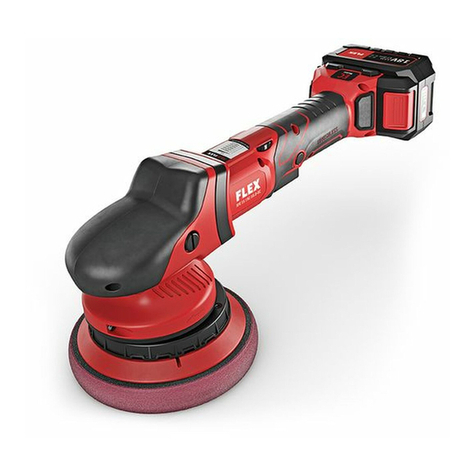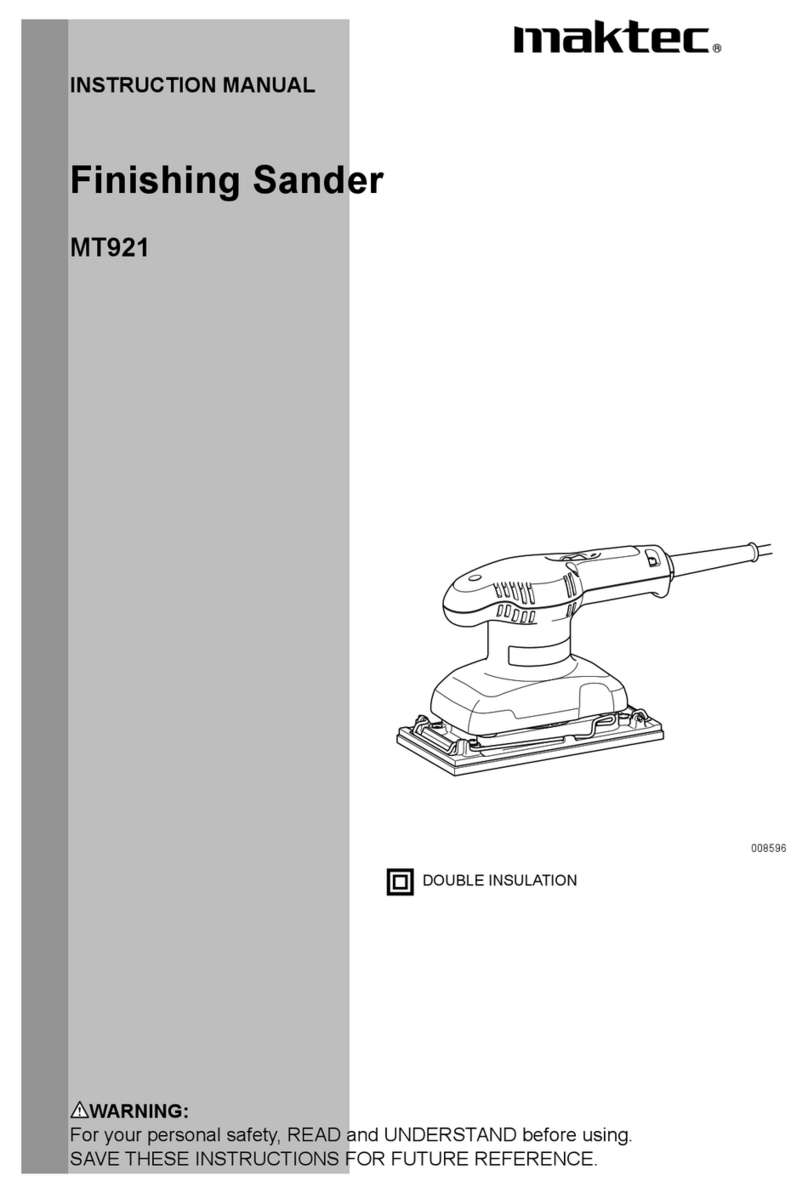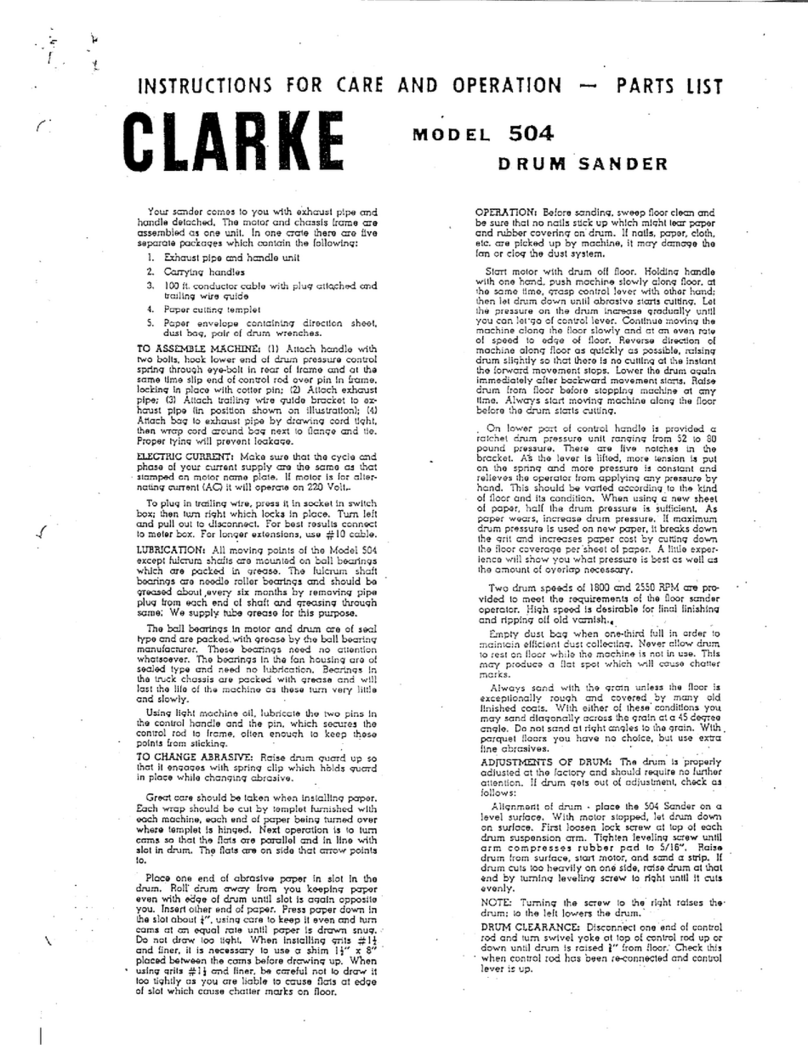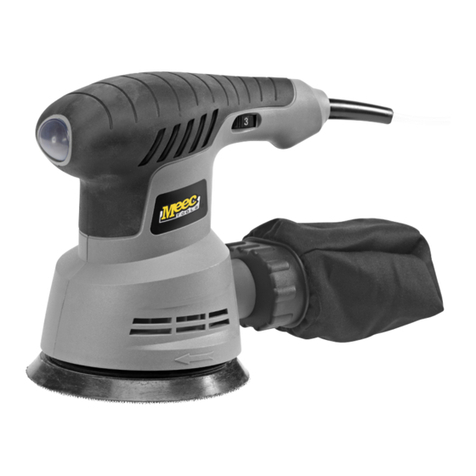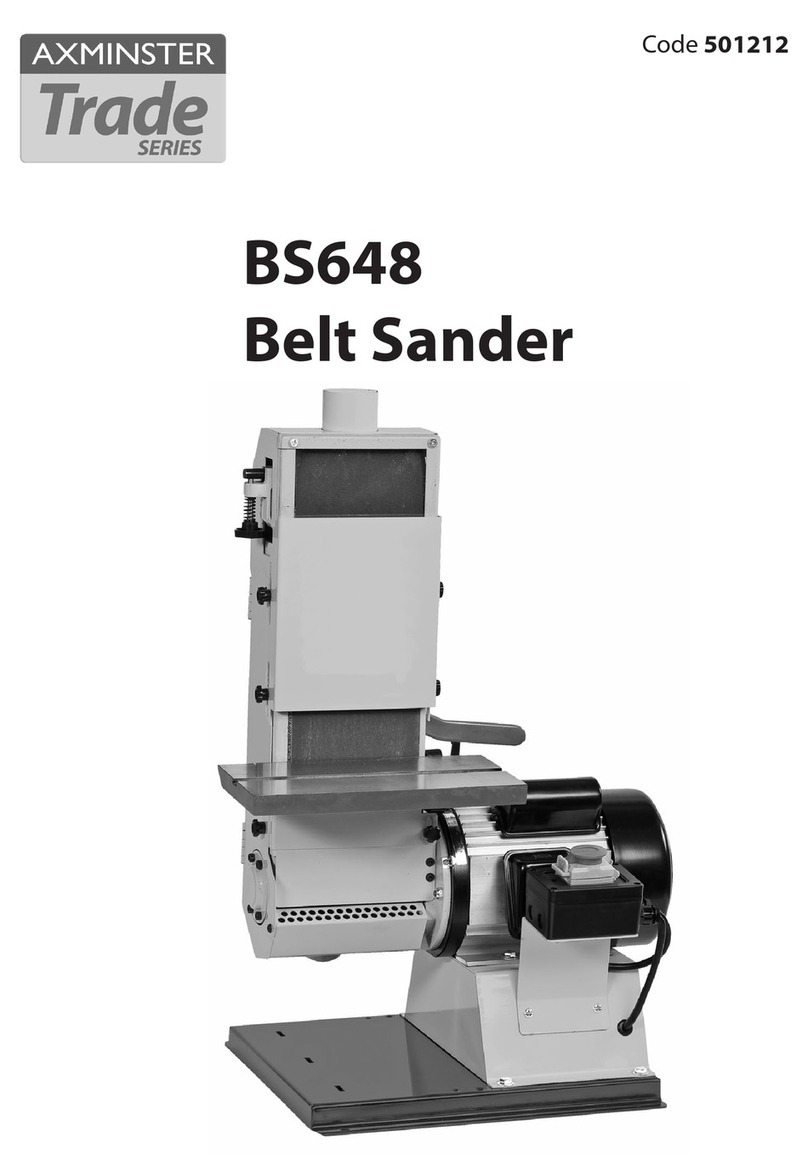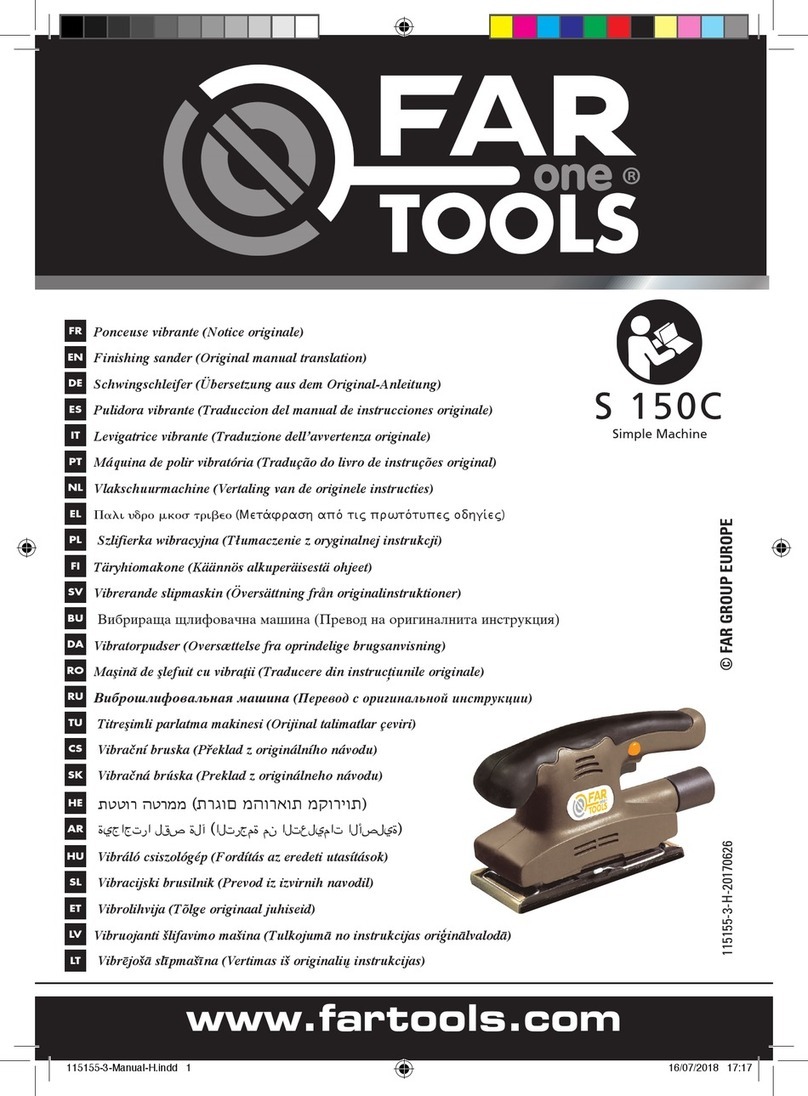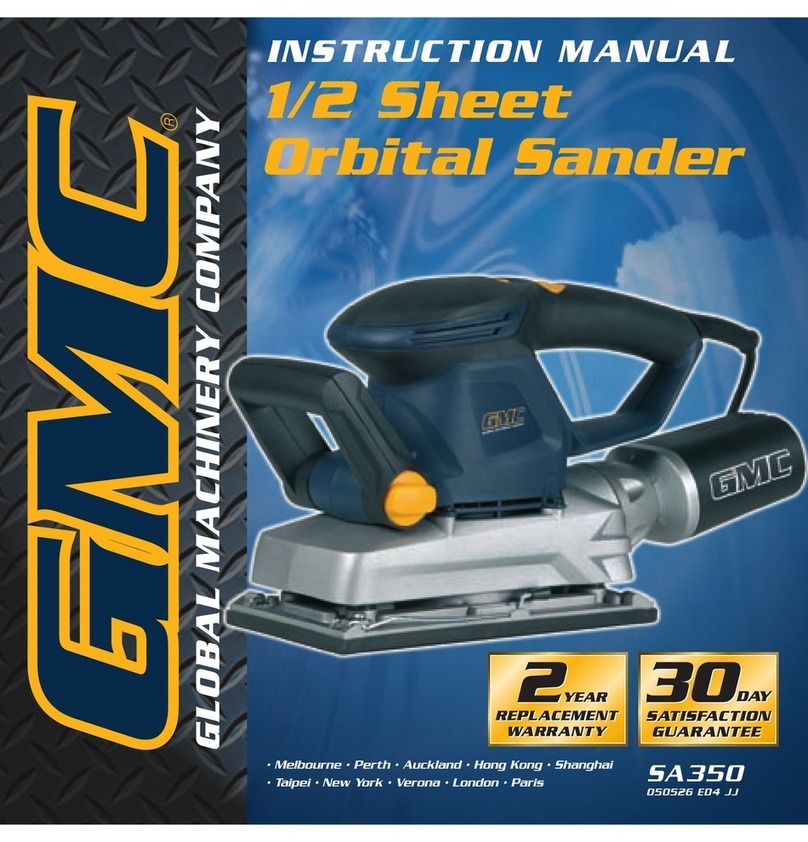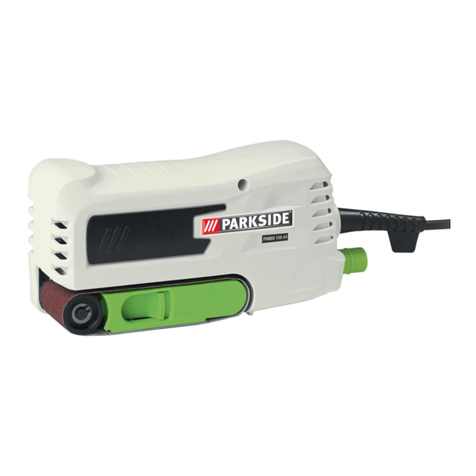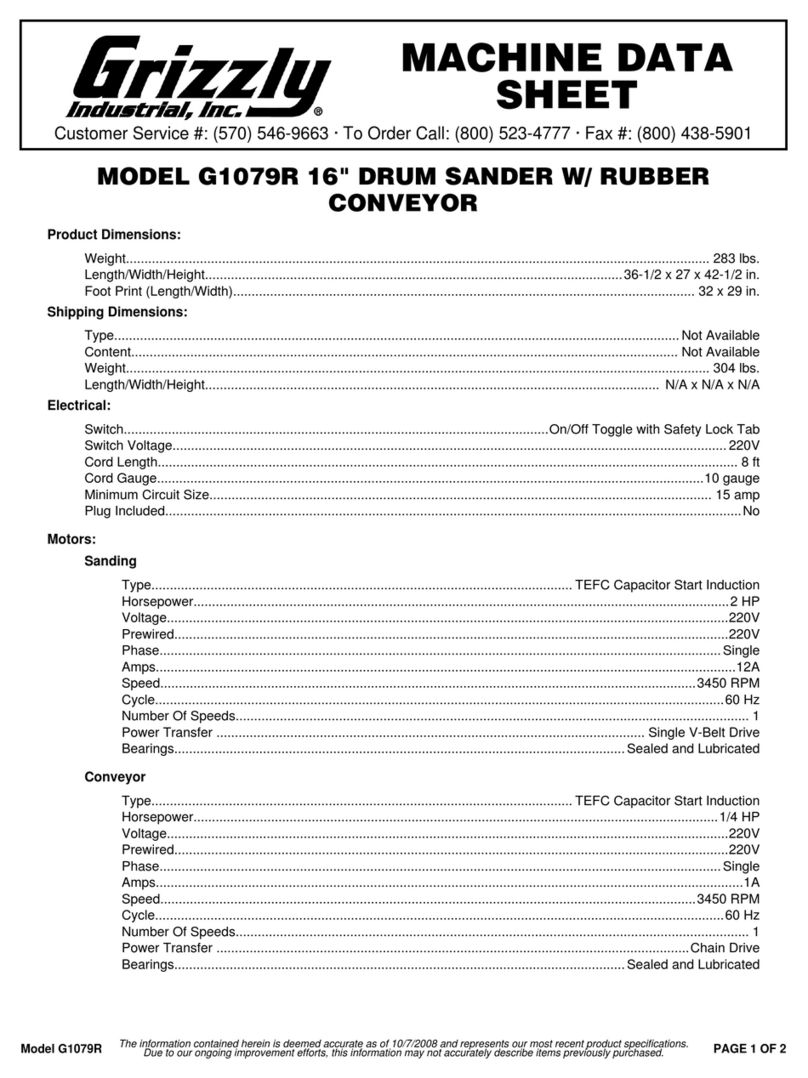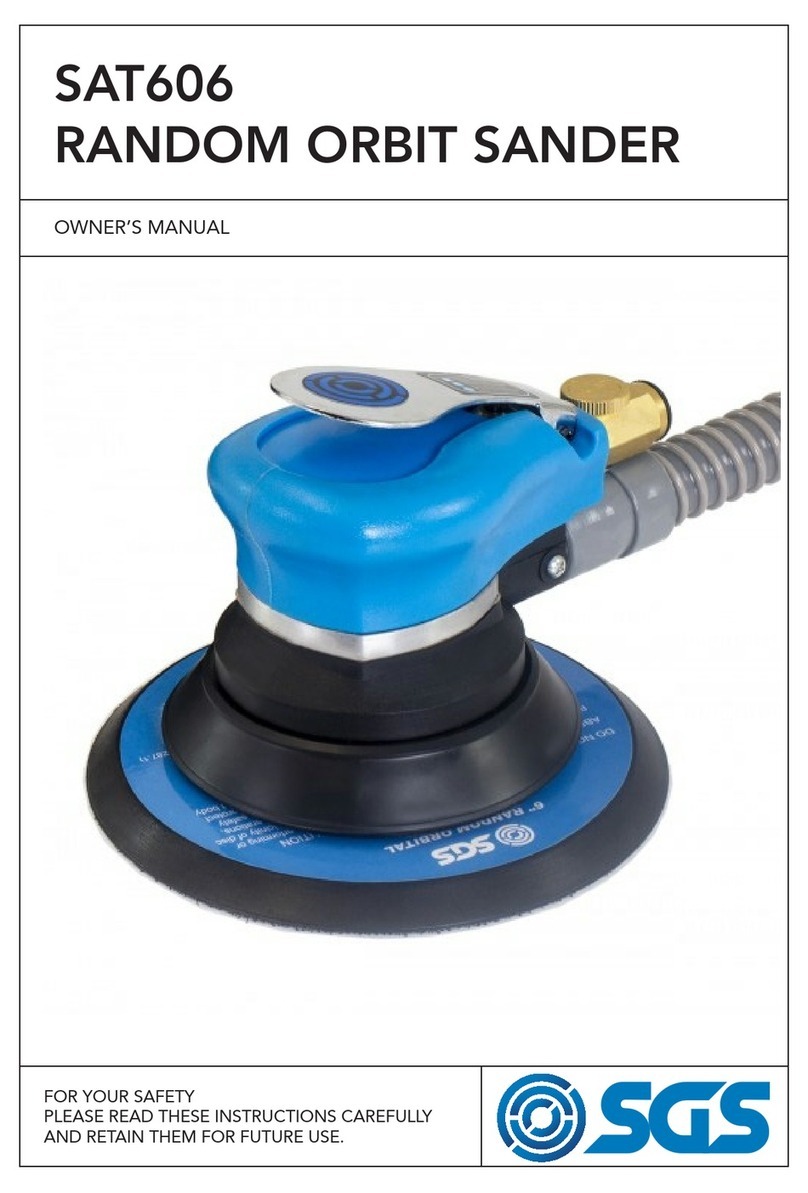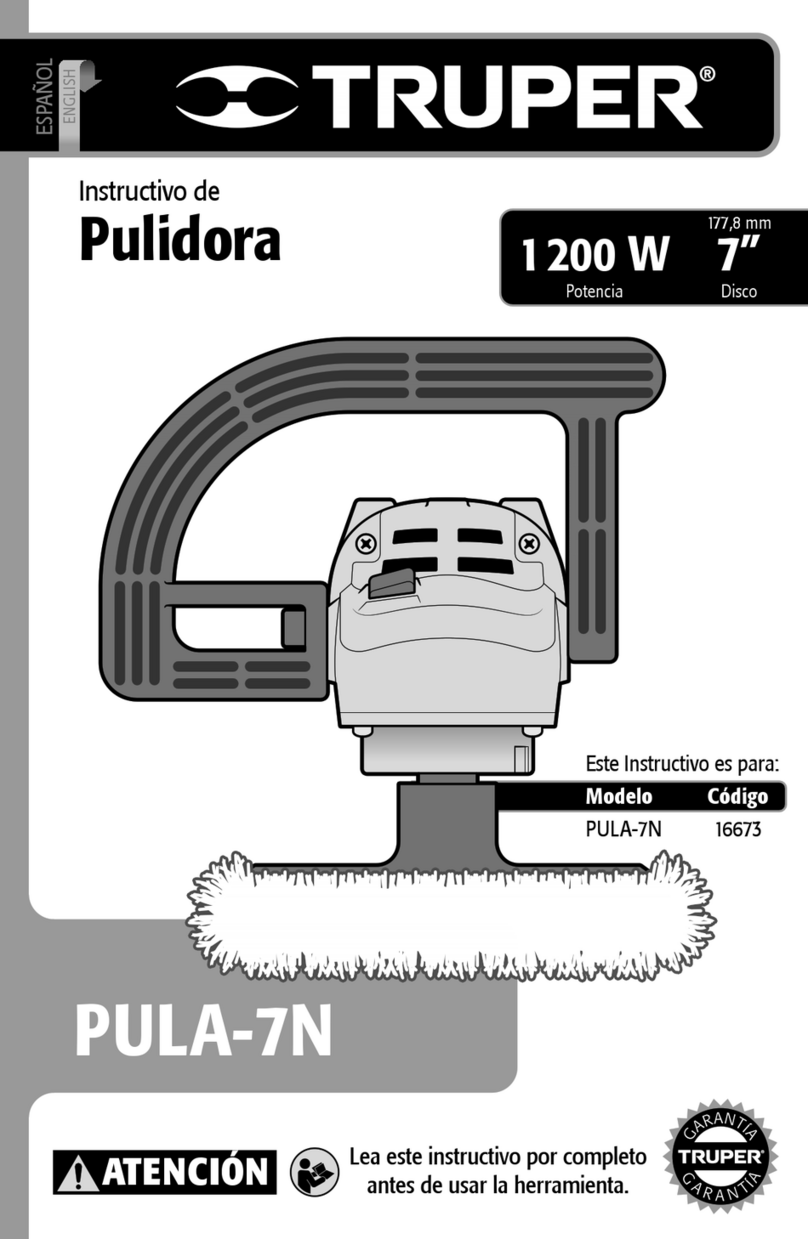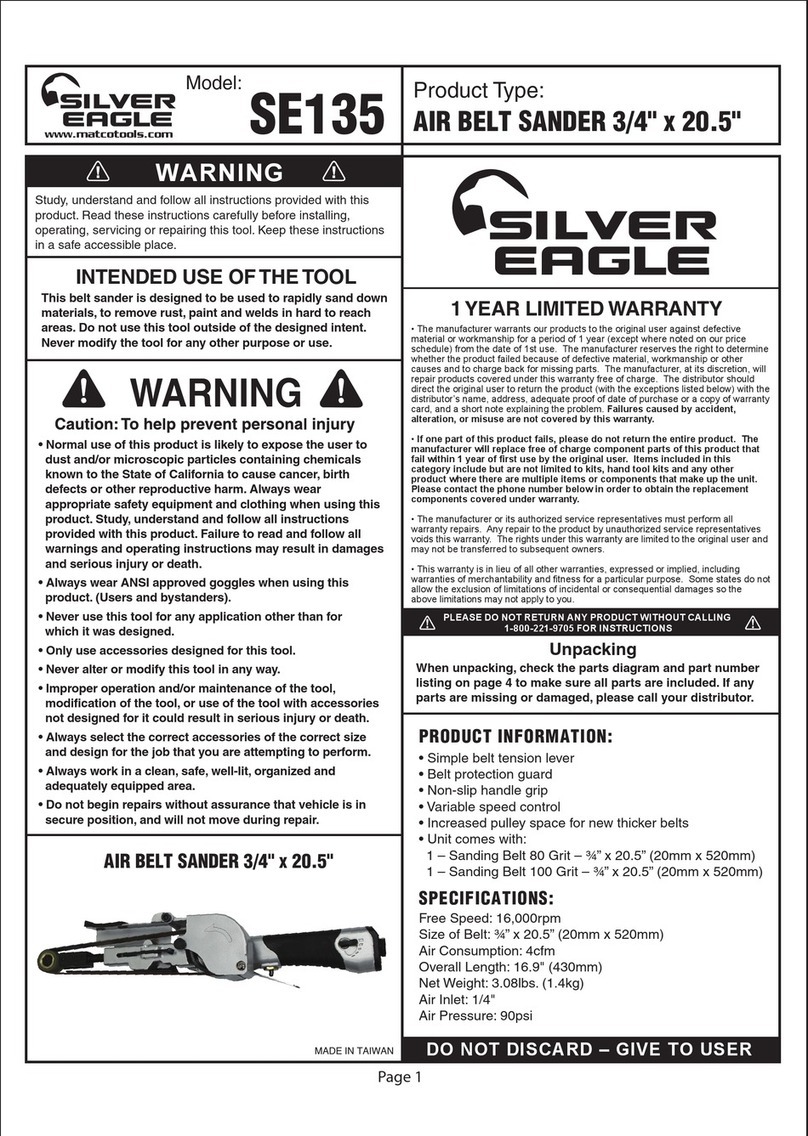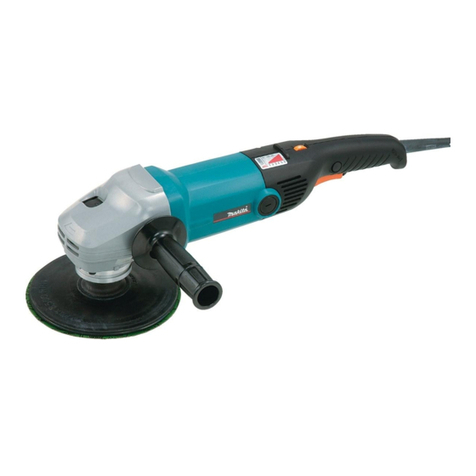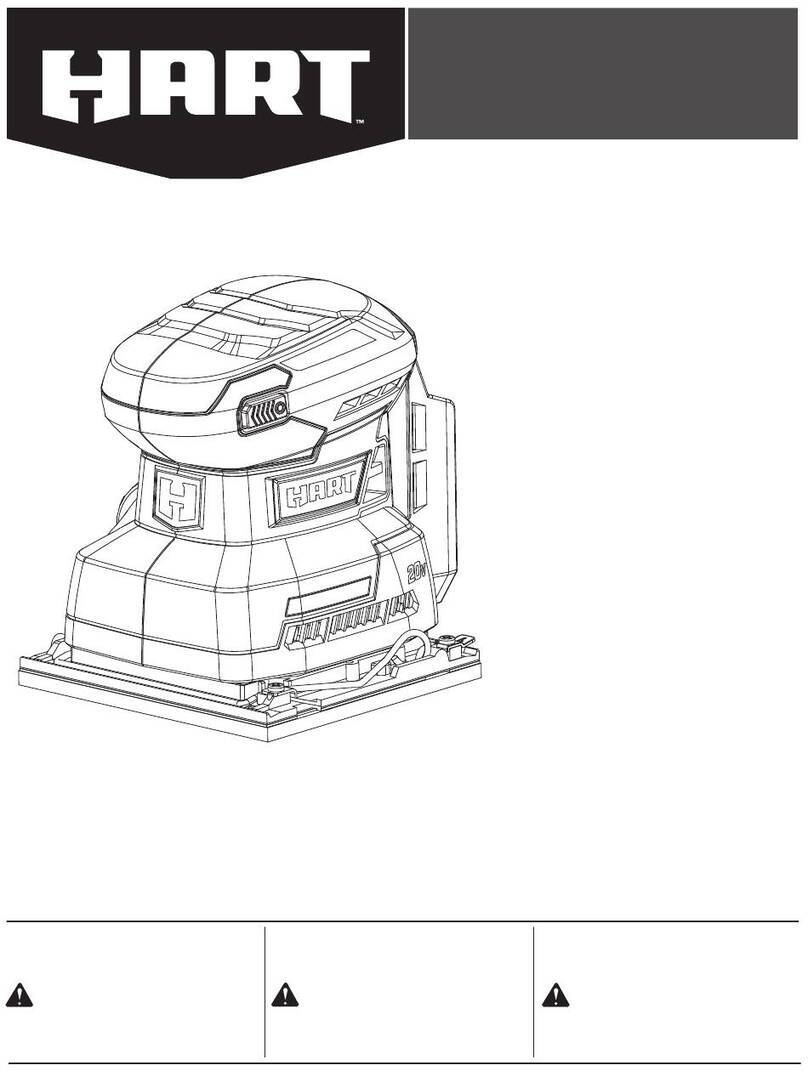Terratek T12VOS User manual

12V Li-ion Cordless Orbital Sander
T12VOS
User Manual— Please read and retain for future reference.
IMPORTANT: Read all instructions before use.

Contents
Parts List
Parts List
Safety Instructions
Technical Information
Using your sander
Maintenance
Warranty
1
No. Description No. Description
1 Sander paper 18 Gear
2 Screws ST3.5X8 19 Small gear
3 Screws ST2.2X10 20 Needle bearing
4 Flat plate 21 screws M3X6
5 Fixed plate 22 Spring Washer
6 Screws ST3X14 23 Locator card
7 Plate 24 Motor
8 Right sleeve 25 Right housing
9 Rubber ring 26 Switch button
10 Bearing 628-2Z 27 Power generate lug holder
11 Swinging mounting 28 Switch
12 Bearing spring circlip diameter 12 29 Wire
13 Counter balance 30 Spring straight pin
14 Washer 31 Battery pack
15 Swinging mounting 32 Left housing
16 Eccentric shaft 33 Left sleeve
17 Bearing 6000-2Z 34 Fast charger

2
Exploded Assembly Diagram
NOTICE: Actual product may vary from pictures shown.

3
2
3
1
5
4
fig.1
fig.2
1. Sanding Pad
2. On/Off switch
3. Soft grip handle
4. Battery pack
5. Charger
Tabs
Charge indicator
Battery capacity indicator LED

4
Technical Information
Model: T12VOS
Rated Voltage: 12V DC
No-load Speed: 10000 /min
Orbital diameter: 1.6 mm
Battery Type: 1300 mAh Li-ion
Charger
Charging time: 1 hour
Input: 100-240V AC, 50 – 60 Hz, 27W
Output: 12.6V DC, 1500mA Max
Read this entire manual before using this product.
Failure to do so can result in serious injury. Save this manual
for future reference.
Copyright© 2013 by ACL Group (Intl) Ltd. All rights reserved. This manual or any artwork
contained herein must not be reproduced in any shape or form without the express written
consent of ACL Group (Intl) Ltd. Diagrams within this manual may not be drawn
proportionally. Due to continuing improvements, actual product may differ slightly from the
product described herein.

5
Read and Keep This Manual
Please read carefully all instructions within this manual. Failure to follow all safety warnings
can result in serious personal injury. The term “Power Tool” in all of the following warnings
refers to your mains operated (corded) or battery operated (cordless) power tool.
This symbol is to warn you of potential personal injury
hazards. Please read carefully the notes along side this warning
to avoid possible injury or death.
Keep work area clean and well lit.
Cluttered or dark areas invite accidents.
Do not operate power tools in explosive atmospheres, such as in the presence of flammable
liquids, gases or dust. Power tools create sparks which may ignite the dust or fumes.
Keep children and bystanders away while operating a power tool. Distractions can cause you
to lose control.
Important SAFETY Information
General Safety Rules
Work area safety
WARNING! Read all instructions. Failure to follow all instructions
listed below may result in electric shock, fire and/or serious injury.
The term “power tool” in all of the warnings listed refers to corded or
cordless power tools.

6
Personal safety
Power tool use and care.
Keep your power tool clean and well serviced at all times.
Never adjust or service any power tool before disconnecting from the mains electricity supply.
Always use the correct tool for the job.
Never force the tool to work harder than it is designed to do.
Never use your power tool with broken parts such as switches, guide fences or leg stands.
ALWAYS keep your power tools away from children.
Keep cutting tools sharp to ensure less stress on the motor.
Only have your power tool serviced by a qualified repair agent using manufacturers
recommended parts.
Before use, ensure that the power outlet you are using matches the plug on your power tool
and that the voltage of the outlet matches that of your power tool.
Only use grounded extension cords with power tools fitted with 3 pin plugs and if using
outdoors ensure any extension cord is suitable for outdoor use.
Always try to avoid body contact with grounded surfaces, such as radiators, cooking ranges
and any other fixed appliance with metal surfaces.
Do not expose your power tool to wet or damp conditions and NEVER use in rain.
Check regularly the power cord of your machine and any extension cord that you are using
for damage.
Do not carry or pull the machine with the power cord.
Ensure the cord is clear from hot surfaces, oil or sharp objects.
Never use your power tool whilst under the influence of alcohol, drugs or medication.
Tiredness can often cause accidents, stay alert.
Never use your power tool without the correct guards in place.
Always use approved eye protection and dust mask. Non slip safety shoes and hearing
protectors should be worn at all times when using your power tool.
Ensure any dust collecting device supplied with your machine is connected correctly before
use.
Ensure all loose clothing, long hair or jewelry is kept clear of the machine.
Before plugging your power tool into the power outlet ensure the power tool is in the OFF
position.
Check that wrenches or adjusting keys have been removed. Any wrench or key left attached
to a moving part can result in injury.
Electrical safety

7
GENERAL SAFETY INSTRUCTIONS
Read this owner's manual completely and make sure you understand all of its safety
guidelines.
WARNING:
For your own safety read Instruction Manual before operating your power tool.
A) Wear eye protection.
B) Keep hands out of the path of cutting tools.
C) Do not operate tool without guards in place.
D) Do not perform any operation freehand.
E) Never reach around cutting tools.
F) Turn off tool and wait for cutting tools to stop before moving work piece or changing settings.
G) Disconnect power (or unplug tool) before changing cutting tools or servicing.
1. KEEP GUARDS IN PLACE
and in working order.
2. REMOVE ADJUSTING KEYS & WRENCHES.
Before turning on the power tool, make sure
the keys and adjusting wrenches have been removed.
3. KEEP WORK AREA CLEAN.
Cluttered areas and benches invite accidents.
4. ALWAYS REMAIN ALERT WHEN THE TOOL IS IN USE.
Inattention on the part of the
operator may lead to serious injury.
5. DON’T USE IN A DANGEROUS ENVIRONMENT.
Don’t use power tools in damp or wet
locations or expose them to rain. Keep work area well lit.
6. KEEP CHILDREN AWAY.
All visitors should remain at a safe distance from work area.
7. MAKE WORKSHOP CHILD-PROOF
with padlocks, master switches or by removing
starter keys.
8. USE THE RIGHT TOOL.
Don’t force a tool or attachment to do a job for which it was not
designed.
Service
Have your power tool serviced by a qualified repair person using only identical
replacement parts.
This will ensure that the safety of the power tool is maintained.
Develop a periodic maintenance schedule for your tool. When cleaning a tool be
careful not to disassemble any portion of the tool since internal wires may be
misplaced or pinched or safety guard return springs may be improperly mounted.
Certain cleaning agents such as gasoline, carbon tetrachloride, ammonia, etc. may damage
plastic parts.
When servicing a tool, use only identical replacement parts. Follow instructions in
the Maintenance section of this manual.
Use of unauthorized parts or failure to follow
Maintenance Instructions may create a risk of electric shock or injury.

8
9.
USE THE PROPER EXTENSION CORD.
Make sure your extension cord is in good
condition. When using an extension cord, be sure to use one heavy enough to carry the
current your product will draw. An undersized cord will cause a drop in line voltage resulting
in loss of power and overheating. If in doubt, use the next heavier gauge. The smaller the
gauge number, the heavier the cord.
10.
DON’T FORCE THE TOOL.
It has been designed to operate at maximum safety and
performance levels.
11.
DO NOT FORCE THE MATERIAL BEING CUT.
Always let the tool cut at its own speed.
12.
WEAR PROPER APPAREL.
Do not wear loose clothing, neckties, rings, bracelets or other
jewelry which may get caught in moving parts. Non-slip foot wear is recommended. Wear
protective hair covering if you have long hair.
13.
ALWAYS USE SAFETY GLASSES.
Also use face or dust mask for commercial cutting
operations. Everyday eyeglasses only have impact-resistant lenses, they are NOT safety
glasses.
14.
SECURE WORK.
Use clamps or a vise instead of your hand to hold work when practical.
This safetyprecaution allows for proper tool operation using both hands.
15.
DON’T OVERREACH.
Keep proper footing and balance at all times.
16.
MAINTAIN TOOLS WITH CARE.
Keep tools clean and in good working condition for
maximum safety performance. Follow instructions for lubricating and changing accessories.
17.
DISCONNECT TOOLS BEFORE SERVICING
– when changing accessories, such as
blades, bits, cutters, etc.
18.
REDUCE THE RISK OF UNINTENTIONAL STARTING.
Make sure switch is in OFF
position before plugging in.
19.
USE RECOMMENDED ACCESSORIES.
Consult the owner’s manual for recommended
accessories. The use of improper accessories may increase risk of injury.
20.
MAKE SURE YOU USE THE CORRECT TOOL
for the job you are doing.
21.
NEVER STAND ON TOOL.
Serious injury could occur if the tool is tipped or if the cutting
tool is unintentionally contacted.
22.
CHECK DAMAGED PARTS.
Before further use of the tool, damaged part(s), (i.e., guard)
should be carefully checked to determine that it will operate properly and perform its intended
function. Check for alignment of moving parts, binding of moving parts, breakage of parts,
mounting and any other condition that may affect the tools operation. A guard or other part
that is damaged should be properly repaired or replaced.
23. Replace damaged blades/cutters immediately.
DO NOT USE DAMAGED BLADES/CUTTERS.
They may cause bodily injury.
24.
DIRECTION OF FEED.
Feed work into the blade/cutter against the direction of rotation of
the blade/cutter only.
25.
DO NOT ALTER THE PLUG.

9
26.
NEVER LEAVE TOOL RUNNING UNATTENDED.
Turn power off. Don’t leave tool until it
comes to a complete stop.
27. Double Insulation eliminates the need for the three wire grounded power cord and
grounded power supply system.
This power tool is supplied with all the relevant safety guards and features, it should be
checked before every operation, this manual should be read and kept in a safe place. Whilst
we warn of all the possible risks attached to using power tools any operator must have read
and understood the manual and apply their own caution and common sense when using this
power tool.
Following this guide will greatly reduce your risk of electric shock or injury.
Only use qualified repair agents to service this power tool.
Only use qualified electrician to repair any damaged wiring.
NEVER remove the grounding prong from the power tool or extension cord.
ĚĚŝƟŽŶĂůƐĂĨĞƚLJ/ŶƐƚƌƵĐƟŽŶƐ
Cordless sander
This tool may only be used for dry grinding/sanding operations.
Wear hearing protection.
Exposure to noise can cause hearing loss.
Always wear eye protection.
Hold power tool by the insulated gripping surfaces, when performing an
operation where the cutting tool may run into hidden wiring.
Contact with a “live”
wire will make exposed metal parts of thetool “live” and shock the operator.

10
When working with the machine, always hold it firmly with both hands and provide
for a secure stance.
The power tool is guided more secure with both hands.
Keep your workplace clean.
Blends of materials are particularly dangerous. Dust from light
alloys can burn or explode.
Always wait until the machine has come to a complete stop before placing it down.
Before any work on the machine (e. g., maintenance, tool change, etc.) as well as
during transport and storage, set the rotational direction switch to the centre
position.
Unintentional actuation of the On/Off switch can lead to injuries.
Avoid unintentional switching on. Ensure the On/Off switch is in the off position
before inserting battery pack.
Carrying the power tool with your finger on the On/Off
switch or inserting the battery pack into power tools that have the switch on invites accidents.
Do not open the battery.
Danger of short circuiting.
Protect the power tool against heat, e. g., also against continuous sun irradiation
and fire.
There is danger of explosion.
In case of damage and improper use of the battery, vapors may be emitted. Provide
for fresh air and seek medical help in case of complaints.
The vapors can irritate the
respiratory system.
When the battery is defective, liquid can escape and come into contact with adjacent
components.Check any parts concerned.
Clean such parts or replace them, if required.

11
V…………………………volts
A…………………………amperes
Hz……………………….hertz
~…………………….….alternating current
…/m……………….....revolutions per minute
.....................class II construction (double insulated)
Kg………………………..kilograms
n
0
………………………..No load speed
……………….….....Conforms to European Harmonised New Approach Directives.
DC ………………..…….Direct Current
Battery use and care
A battery operated tool with integral batteries or a separate battery pack must
be recharged only with the specified charger for the battery.
A charger that may be suitable for one type of battery may create a risk of fire when used
with another battery.
Use battery operated tool only with specifically designed battery pack.
Use of any other batteries may create a risk of fire.
Hold the tool by its handle only. Because the tool operates by battery power, be aware of
the fact that it can begin to operate at any time.
Charging the battery pack
(Fig. 2)
Note:
Newly purchased Batteries are not fully charged and must be charged before using
in your cordless tool(s).
1. Plug the battery charger into the proper AC voltage source.
2. Insert the battery pack so that the ribs on the battery pack slide into the grooves on the
battery charger. Insert the cartridge fully into the charger. (Fig.2)
3. When the battery pack is inserted, the Red LED will light, indicating the charger has
started the charging cycle. A Green light will indicate the battery is completely charged
and should be removed from the charger. (Fig.2)
4. After charging, unplug the charger from the power source.
5. Other tips for extending Battery life: Do not store batteries completely discharged.
Charge them fully before storing.
Symbols
IMPORTANT:
Some of the following symbols may be used on your tool.

12
Overload Protection
The power cutter is fitted with an overload/overheat protection device. When the tool is
forced to work at an excessive load, the protection device will be activated automatically
to disconnect the power supply. If this occurs, switch off the tool and switch on again to
resume the work, make sure to apply only suitable workload to the tool. When the tool
works under heavy load for a long period of time, the temperature of the tool or battery
pack will increase significantly. The protection device will be activated at a preset temperature
to protect both the tool and the battery. If this occurs, switch off the tool and wait until it
cools down to ambient temperature and resume work.
Note:
when the voltage of battery pack is dropped to 7.5V, the protection device will also be
activated. In this case, remove the battery pack and fully charge it before reuse.
WARNING: Improper use of the battery or battery charger can lead to serious injury.
To avoid these injuries:
A)
NEVER
disassemble the battery.
B)
NEVER
incinerate the battery, even if it is damaged or is completely worn out. The battery
can explode in a fire.
C)
NEVER
short-circuit the battery.
D)
NEVER
insert any objects into the battery charger’s air vents. Electric shock or damage
to the battery charger may result.
E)
NEVER
charge outdoors. Keep the battery away from direct sunlight and use only where
there is low humidity and good ventilation.
F)
NEVER
charge when the temperature is below 32°F (0°C) or above 104°F (40°C).
G)
NEVER
connect two battery chargers together.
H)
NEVER
insert foreign objects into the hole for the battery or the battery charger.
I)
NEVER
use a booster transformer when charging.
J)
NEVER
use an engine generator or DC power to charge.
K)
NEVER
store the battery or battery charger in places where the temperature may reach or
exceed 104°F (40°C).
L)
ALWAYS
operate charger on standard household electrical power (230 volts). Using the
charger on any other voltage may overheat and damage the charger.
M)
ALWAYS
wait at least 15 minutes between charges to avoid overheating the charger.
N)
ALWAYS
disconnect the power cord from its receptacle when the charger is not in use.

13
ADDITIONAL PRECAUTIONS FOR CHARGER & BATTERY PACK
Specific Safety Rules
CAUTION: Remove all nails, staples, fasteners, foreign objects or other debris before sanding.
Never sand over these objects.
Never use the sander without a sanding disc attached. Damage to the work piece and sander
could result.
Start and stop the sander before contacting the work piece. Allow the weight of the tool to do
most of the work. In most cases additional pressure will not be required. Move the sander
evenly over the work surface maintaining constant motion. Prolonged operation in one location
can cause uneven surfaces.
For best results change sandpaper frequently and never use the sander without sandpaper or
damage to the base could result.
Always wear eye protection and a dust mask for dusty applications and when sanding
overhead.
Sanding particles can be absorbed by your eyes and inhaled easily and may cause
health complications.
1. Do not charge battery pack when temperature is below 10°C (50°F) or above 40°C (104°F).
2. Do not attempt to use a step-up transformer, an engine generator or DC power receptacle.
3. Do not allow anything to cover or clog the charger vents.
4. Always protect the battery terminals when the battery pack is not used.
5. Do not short the battery pack.
6. Do not touch the terminals with any conductive material.
7. Avoid storing battery cartridge in a container with other metal objects such as nails,
coins, etc.
8. Do not expose battery pack to water or rain.
Warning!
A battery short can cause a large current flow, overheating, possible burns and
even a breakdown.
9. Do not store the tool and Battery pack in locations where the temperature may reach or
exceed 50°C (122°F).
10. Do not incinerate the Battery pack even if it is severely damaged or is completely worn
out. The battery pack can explode in a fire.
11. Be careful not to drop, shake or strike battery.
12. Do not charge inside a box or container of any kind. The battery must be placed in a
ventilated area during charging.

14
Unpacking
Carefully remove the product and any accessories from the box. Make sure that all items
listed in the packing list are included.
Package contents
A) 12V cordless sander
B) 1 hour fast Charger
C) User manual
D) 10 pcs sanding paper
Functional Description
(Fig.1)
WARNING: Remove battery pack before making any assembly, adjustments or
changing accessories. Such preventive safety measures reduce the risk of starting the tool
accidentally.
Operation
CAUTION! Always be sure that the tool is switched off before assembly, including
insertion or removal of the battery pack.
Use special precautions when sanding chemically pressure treated lumber, paint
that may be lead based, or any other materials that may contain carcinogens.
A suitable
breathing respirator and protective clothing must be worn by all persons entering the work
area. Work area should be sealed by plastic sheeting and persons not protected should be
kept out until work area is thoroughly cleaned.
Hold power tools by insulated gripping surfaces when performing an operation
where the tool may contact hidden wiring.
Contact with a “live” wire will make exposed metal parts of the tool “live” and shock the operator.
Wear ear and eye protection.
To avoid serious injuries.
Be aware that this tool is always in an operating condition, since it does not have to be
plugged into an electrical outlet.
Do not touch the rotating parts to avoid injury.
Do not use the tool continuously for a long period of time. Stop using the tool from time to
time to avoid overheating of the motor.
Do not drop the tool.

15
Attaching a Sanding Paper
WARNING!
Never use the sander unless the entire base is fitted with sanding paper.
Note:
this tool has a velcro base, only velcro sanding paper can be used on this tool.
1. Select the required grade of sandpaper.
2. Align and stick the sandpaper onto the base of the tool.
Switching on and off
To start the machine, press the ON/OFF switch at the end marked with “_”; to stop the
machine, press the switch at the end marked “o”. (Fig.1-2)
WARNING!
The sander is designed for dry sanding only and under no circumstances
should it be used for wet sanding.
Using the compact orbital sander
WARNING!
Never use the sander unless the entire base is fitted with sandpaper.
The sander is designed for sanding wood, metal, plastic and similar material. It can be used
for sanding and finishing the surfaces.
1. Switch on the sander before you place it on the work piece and move it over the surface to
be smoothed in a circular motion.
2. Take care to hold the sander with its base parallel to the surface of the workpiece, and use
only moderate pressure.
3. If there are still marks on your work piece after sanding, try either going back to a coarser
grade paper and sanding the marks out before resuming with the original choice of grade, or
try using a new piece of sandpaper to eliminate the unwanted marks before going on to a finer
grade and finishing the job.
Warning!
Wear safety goggles, a dust mask and hearing protection. The whole sanding pad
must rest on the work piece.
Installing or removing battery pack.
1. To remove the battery pack, withdraw it from the tool while depressing the tabs (Fig.2)
on both sides of the battery pack.
2. To insert the battery pack, align the ribs on the top of the battery with the grooves in
the housing and slide it into place. Always insert it all the way until it locks in place with a
little click. Lightly pull on the battery pack to ensure it is locked into place and will not
accidentally fall out of the tool, causing an injury.
3. Do not use force when inserting the battery pack. If the battery does not slide in easily,
it is not being inserted correctly.

16
Disposal
Power tools, accessories and packaging should be sorted for environmentally-friendly recycling.
Only for EC countries:
Do not dispose of power tools into household waste!
According to the European Directive 2002/96/EC on waste electrical and
electronic equipment and its incorporation into national right, products
that are no longer suitable for use must beseparately collected and sent
for recovery in an environmentally-friendly manner.
Li-Ion:
Do not dispose of battery packs/batteries into household waste, water
or fire. Battery
packs/batteries must be collected, recycled or disposed of in an
environmentally-friendly way.
Only for EC countries:
Defective or dead batteries must be recycled according to the directive 2006/66/EC.
Battery packs/batteries:
Disposal of the exhausted battery
WARNING:
Do not dispose of the exhausted battery. The battery must explode if
it is incinerated. The product that you have purchased contains a rechargeable
battery. The battery is recyclable. At the end of its useful life, under various state
and local laws, it may be illegal to dispose of this battery into the municipal waste
stream. Check with your local solid waste officials for details in your area for
recycling options or proper disposal.
MAX 50ºC
Li-Ion
LED Capacity indicator:
(Fig.2)
$OOWKUHH/('ĻVDUHRQ!
7ZR/('ĻVDUHRQ!
2QH/('LVRQ
Once only the one LED is lit, the battery must be re-charged.

17
Accessories
CAUTION:
Use only accessories or attachments recommended for use with your Terratek tool
specified in this manual. The use of any other accessories or attachments might present a risk
of injury to persons. Only use accessory or attachment for its stated purpose.
General Maintenance
1. Keep the air vents free from obstruction and clean regularly.
2. Check regularly for any dust particles entering the grills around the motor and the switch.
Use a soft brush to remove any dust particles. Wear safety glasses to protect your eyes whilst
cleaning.
3. Monitor the dust bag (if equipped) and empty when approximately half full. Always empty
into an appropriate container. REMEMBER: dust can be hot and cause fire.
4. If the sand paper has become dull, replace it. Dull sand paper will cause increased tear-out
and ragged edges on the cuts.
5. Lubricate all moving parts at regular intervals.
6. To clean the body of the power tool, only use a dry soft cloth. Do NOT immerse in water.
Do not use any petrol or any alcohol based product.
Maintenance
Use only a dry, soft cloth for wiping the unit. Do not use a damp cloth, thinner, or other volatile
solvents for cleaning.

18
We ACL Group (Intl.) Ltd, England DN6 8LZ declare that the cordless sander has been
manufactured according to our full quality assurance procedures.
The declaration is to certify that it conforms to CE, EMC, MD and RoHS directives:
EN55014-1/A1:2009
EN55014-2/A2:2008
All provisions of Annex 1 of Council Directive 2004/108/EC – EMC directive
EN60745-1/A11: 2010
EN60745-2-4: 2009
All provisions of Annex 1 of Council Directive 2006/42/EC – Machinery Directive
RoHs 20/5/EU
Mr. Alan Garnett, UK QA Manager
2011/65/EU

19
Please read the following carefully
ACL Group (Intl) Ltd. and/or it’s distributor has provided the parts list and assembly diagram
as a reference tool only. Neither ACL Group (Intl). Ltd. or its distributor makes any
representation or warranty of any kind to the buyer that he or she is qualified to do any
repairs or replace any parts of this product. ACL Group (Intl) Ltd. and its distributor expressly
state that all repairs or parts replacement should be done by certified or licensed technicians.
The buyer assumes all risk and liability arising out of his or her repairs or parts replacement to
the original product.
12 Months Limited Warranty
If within 12 months from the date of purchase you experience any problems with your product,
please return the product to its distributor/dealer for repair or replacement. This warranty
DOES NOT COVER
normal wear, or any damage as a result of accidents, misuse, abuse or
negligence.
ACL Group (Intl) Ltd
Doncaster, England
Email: [email protected]
www.terratekintl.com
Environmental Protection
RECYCLING: WASTE ELECTRICAL PRODUCTS SHOULD NOT BE DISPOSED OF WITH
HOUSEHOLD WASTE. PLEASE RECYCLE WHERE FACILITIES EXIST. CHECK WITH YOUR
LOCAL AUTHORITY OR RETAILER FOR RECYCLING ADVICE.
Table of contents

